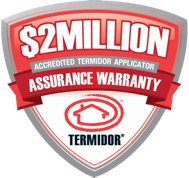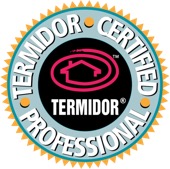There are three distinct groups into which termites (white ants) are divided:
- Subterranean
- Dry wood
- Dampwood.
Subterranean termites are the most destructive type and pose the greatest threat. Their scissor-like jaws are as sharp as shears. They eat away wood substances one tiny bit at a time. You’ll regret greatly if you give them the luxury of time.
Subterranean termites normally live in colonies underground. Occasionally, you’ll also find them in some moist hidden areas above ground. Their population can number as high as two million per colony.
One visible way to detect their presence is the sighting of mud tubes. They build mud tubes in the open areas along the route from their colony to the food source. They do so with the primary objective of protecting themselves from their predators and light.
Drywood termites don’t live underground in the soil like subterranean termites. They don’t need moisture and soil to build their nests or colonies. Instead, their colonies are established within the wood itself. In other words, they build their nests in places like wooden door frames, wooden window frames, wooden fence poles, wooden furniture and the likes.
Dampwood termites, Termopsidea, are always associated with damp, decaying wood, usually in the form of fallen logs in the forest, but may sometimes be found in decaying wood in buildings or fences. They depend on the moisture in the tree and mostly have galleries in the softer growth rings of the tree. They do not form a large central colony but live in many small independent groups or colonies in the wood.
Dampwood termites are found only in wood with high moisture content.
Most of the species of termites (white ants) that damage timber-in-service in Australia are subterranean termites.
Of them all Mastotermes darwiniensis and Coptotermes spp. are the most destructive.
Coptotermes acinaciformis is responsible for more economic loss than all the other Australian species combined.This is due to its extensive range, the severity of its attack, and its ability to survive in built-up areas such as cities and large towns.
There are around 300 species of termites (white ants) in Australia! This is the common ones in the Victoria region.
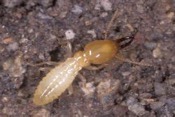
Soldier 4.75mm±2mm
Heterotermes Ferox
Commonly found throughout Victoria - particularly in urban areas or where eucalypt gum trees are highly prevalent.
Nest Location - Heterotermes ferox often build their colony nest next to stumps, logs, or other timber in direct contact with the soil where some wood decay or rotting is prevalent.
Destructive Nature - Heterotermes ferox are be destructive to damp timbers and are usually found attacking fences, poles and other timber structures subject to wood decay from weathering or from
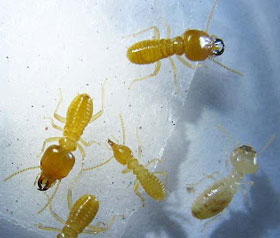
Soldier length: 5 – 7mm Major: 3-5 mm
Schedorhinotermes Intermedius
This genus has two casts of soldiers, the Major Soldier and the Minor Soldier. The head is bulbous. The mandibles have teeth on the inner surface. The Major Soldier has uneven serrations on the base of the mandibles. The Minor soldier is about two-thirds of the length of the major soldier. They have a narrower head and more slender mandibles. Schedorhinotermes, are becoming a major problem termite and are now very wide spread. They are not known to attack Oregon timber. They are often found in bark chips in garden beds. Schedorhinotermes moult infrequently during winter and are hard to control for this reason.
Root crown and lower trunk of living and dead trees (Eucalyptus). Subterranean nests in buried timber in ground or under houses. Young colonies have smaller soldiers. Once nest is well established, major soldiers appear. Distinctively loose honeycomb damage in timber.
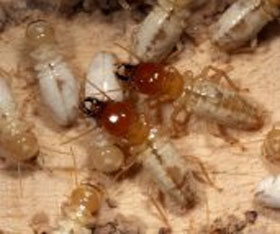
Soldier length: 11 – 13mm
Mastotermes darwiniensis
Very destructive to timbers within 70m of nest. Where food is plentiful, colony will form independent sub-colonies. They are easily recognizable by their size. Identification is confirmed by the number of segments in the lower portion of the leg. They have been known to totally destroy a home within 3 months.
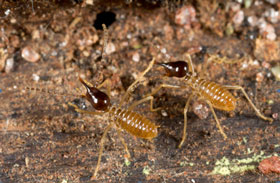
4.2mm
Nasutitermes exitiosus
Commonly found throughout Victoria - particularly in urban areas or where eucalypt gum trees are highly prevalent.
Nest Location - Nasutitermes exitiosus build a mound nest which protrudes 30cm to 75cm above the ground. Control can be as easy as knocking the top off the nest and a follow up insecticide treatment inside the nest.
Destructive Nature - Nasutitermes exitiosus are destructive to buildings and other timber structures. Sometimes severe damage may occur, but not so commonly as the other species listed above.
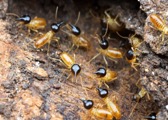
Soldier length: 6mm
Main nest usually in trunk of tree, connected to visible nests on upper trunk or limbs.
IDENTIFICATION
Mostly timber in contact with ground. Seldom causes significant damage to building timbers
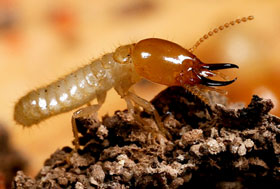
Body size: 4-6 mm Worker: Soldiers ratio is 90%: 10 – 5%
Coptotermes Acinaciformis
Commonly found throughout Victoria - particularly in urban areas or where eucalypt gum trees are highly prevalent.
Nest Location - Coptotermes acinaciformis are a very secretive termite species; they build their nest out of sight, often within the base of eucalyptus or other susceptible trees, or completely under the ground; often within an enclosed patio or under concrete (on ground) flooring which is ideal for moisture retention, temperature and humidity control within the termite colony nest. This species often build subsidiary nests away from the main colony nest. A subsidiary nest can be contained in a wall cavity of a building where there is a reliable moisture source, for example, from a leaking shower recess or faulty guttering or rusted down pipes.
Destructive Nature - Coptotermes acinaciformis are highly destructive to buildings and other timber structures. They are the most widely distributed and destructive timber pest in Australia, accounting for more than 70% of the serious damage to buildings in Victoria. A single colony may consist of more than one million termites. A most voracious timber pest ... one to be taken seriously.
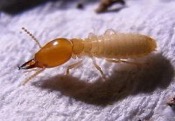
Soldiers at 4 to 5 mm
Coptotermes frenchi
Commonly found throughout Victoria; the most prevalent destructive termite species in the Gippsland and other regions where eucalypt gum trees are present. They are highly active in Melbourne and other urban areas in Victoria, where buildings are constructed of softwood or oregon timber framing.
Nest Location - Coptotermes frenchi most often build their nest in the root crown or lower trunk area of living trees, particularly eucalypts. They may also build their nest as a mound in the dryer areas of Victoria.
Destructive Nature - Coptotermes frenchi can cause severe damage to buildings and other wooden structures. It is common for this species to devour timber framing leaving only a thin veneer. This species is the most shy of the destructive species; they will retreat from a location immediately (for the time being) if disturbed.
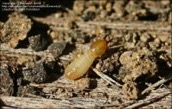
lacteus soldiers at 4 to 4.8 mm
Coptotermes lacteus
the milk termite, is a species of termite in the family Rhinotermitidae
Commonly found in eastern Victoria - particularly prevalent in Melbourne, Gippsland and Albury-Wodonga regions.
Nest Location - this termite species, most often builds its nest as a mound up to 2m above ground level, with hard clay walls, so control is easily effected once located by knocking the top off and insecticide treatment of the nest.
Destructive Nature - Coptotermes lacteus attacks stumps, dead trees, timber fences, poles and other timber structures that are in contact with the soil, being softened by weathering or decay. These termites are also known to attack such timber in damp sub-floor areas.
Dampwood Termites
These termites are always associated with damp, decaying wood, usually in the form of fallen logs in the forest, but may sometimes be found in decaying wood in buildings or fences.
Usually decay precedes the termite attack. Termites that are found in these situations, have no extensive subterranean gallery system, and often have no contact with the soil, are classified as dampwood termites. They depend on the moisture in the tree and mostly have galleries in the softer growth rings of the tree. They do not form a large central colony but live in many small independent groups or colonies in the wood.
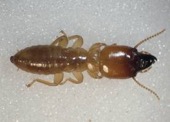
Soldier length: 12mm
Dampwood Termite (Neotermes Insularis)
Dampwood termites such as Neotermes insularis will only attack damp wood. They will frequently eat and attack the subterranean parts of small shrubs & trees, old fence posts, skirting boards, doorframes of buildings, tree stumps, and tree branches dropped to the ground. They will also be commonly found within old wood decks, roof eaves that are damp, showers, bathrooms or any other structures with poor ventilation or moistened timber that is subject to adjacent plumbing leaks.
Dampwood termites will often nest in the wood underneath the soil. They don’t necessarily require direct contact with the soil to obtain their moisture for survival, but often wood with a very high degree of moisture is needed. They are nearly always found in cool, moist and humid locations Small colony in branches and trunks of trees, often in softer growth rings. Serious damages to trees mainly eucalypts.
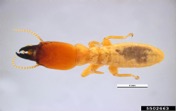
Soldier length: 10mm - 14mm
Dampwood Termite (Porotermes adamsoni)
It attack softwood posts and flooring, hardwood poles, house piers, bridge timbers and fence posts (Hill, 1942). It is of considerable economic importance as a pest of Eucalyptus, especially in south-east Australia and Tasmania, especially in the alpine forests of New South Wales (Greaves, 1962, 1965). It can potentially do more damage than other termites (such as Coptotermes) because it attacks sapwood as well as heartwood and is rarely found attacking houses.
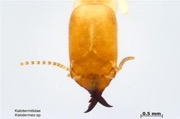
Soldiers 4.0 – 8.5 mm
Dampwood Termite - kalotermes sp
Form small to sometimes large colonies in and around dead wood in species of Eucalyptus and can cause damage in standing power poles.
Our barriers are highly effective against termites (white ants) – Termidor..We offer 8 years written warranty on chemical termite barrier protection.Contact us at Redknight – Experts in Termite protection,Termite extermination,white ant protection, Termite Barriers & Termite inspections in Melbourne, Ballarat and Geelong.
Call 1800 70 90 88 for a free assessment and quote. 24/7/365 Camy.
